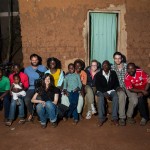SCAD students Karina Yuwano and George Prah recently worked with a team to produce “IMBA MEANS SING”, a documentary film that follows the story of children from Uganda who sing in a choir to raise money for their education. Yuwano, a fourth-year television production major, interned as a production assistant for the film. Prah, a fourth-year graphic design student, aided with some of the design aspects of the film.
Prah says: “[It] is an intimate film that tells the compelling story of four kids from the Grammy-nominated African Children’s Choir as they travel and perform around the world to fund their education and support their impoverished families back in Uganda. More so than that, it’s a story about hope and achieving your goals and aspirations no matter who you are.”
Erin Bernhardt, the producer of the film, further explains, “’IMBA MEANS SING’ is the story of three young Ugandans on a journey that will change their lives forever and help them accomplish their dreams by singing for an education.”
Yuwano adds: “Each of the children has vast dreams whether it’s becoming a pilot, chef, midwife, pastor and even president yet they lack the money and resources to even attend elementary school. Through the African Children’s Choir program, they’re able to be fully funded until university. I think the climax of the whole story is when they return to Uganda after 1.5 year of traveling abroad and they reach the epiphany that their lives are much more different now: they realize they must work a lot harder to make their dreams a reality.”
Yuwano, Prah and Bernhardt all said that working on the film was a rewarding experience.
Yuwano explained: “The most rewarding part was actually meeting the subjects of the documentary. It’s interesting – you’d think that working on a film you’d meet the subjects everyday but it truly depends on the nature of the film, the schedule and your job position … I was working based in Atlanta and would be working on transcribing incoming footage, editing promotional videos and scouting for locations. Because production took place out of Georgia most of the time, I rarely ever got to see the 20 children whose interview videos I had been transcribing all month … When I met Moses, I hugged him right away and it’s funny because he has no idea who I am but I know his full story from all the interview videos.”
Prah says: “Even though I played a very minor role in this project, it feels good to have been part of something that will have a lasting impression and make an impact in our approach to making education accessible to people in need.” He also says he found it very inspiring to be a part of the team that produced the film. “The collective effort extends far beyond the film’s director, cinematographer, editors and even the people in the production team. Every single donation, every single family that hosted the kids as they traveled around the world, every bus driver on the choir’s tour, every translator, every care-taker, every choreographer … I could go on and on but basically I believe it took much more than a production team but a village of every-day people to complete this film. That, I find is the most beautiful part about it. The collective effort of so many people dedicated to a cause to make something inspiring.”
Bernhardt says: “It’s pretty magical now to see what we were able to accomplish with such a tiny foundational team and then the masses of supporters who surrounded us to lift us up. I am forever grateful.” She also explains that “Spending time with the children was by far the best part. I miss them so much and am in dire need of visiting them in Uganda sometime next year!”
Yuwano and Prah had very different roles in the film. Yuwano was a production assistant for the director, Erin Bernhart, and she said: “When the crew were out of town, I would transcribe incoming footage, make promotional videos, organize Erin’s contacts and scout for locations. I also worked on set whenever production took place and assist with talent releases, event coordination and anything else Erin needed. When the production was on hiatus, I would go to the director’s production house and help organize footage and sync it to its audio. In essence, preparing materials for the editor.”
Prah says: “I was more involved with design elements for various fundraising events that took place during the production of the film which included event signage, info-graphics, email newsletters, illustrations and posters. These events were purposed to attract the public’s attention and create awareness and a means to fund the production of the film and they proved to be very successful. I also got to meet the kids from the choir at one of the events. They are so adorable!”
Yuwano says she was very pleased with the outcome of the film. “After watching the movie for the first time on the big screen at the Atlanta Film Festival, I was eternally thrilled to see the pieces come together: the concept by Erin Bernhardt, the vibrant cinematography by Jason Maris, visual direction by Danielle Bernstein, and then blended by the enchanting music by the African Children Choir themselves. I brought two of my masculine male friends and they both cried which is a great sign that the film was a success.”
Working on “IMBA MEANS SING” wasn’t without its difficulties. Bernhardt says: “There were new and difficult challenges every single day. Making this film was by far the hardest thing I’ve ever done in my life. I can’t believe we did it and that it’s already so successful. Managing so many talented artists and interns and donors and trying to make that work with a non-profit and fundraising all the at same time was crazy.”
To find out more about IMBA MEANS SING, visit their website or see their press materials.

































